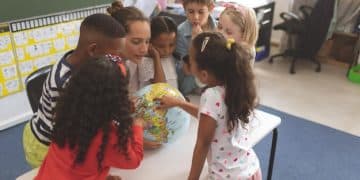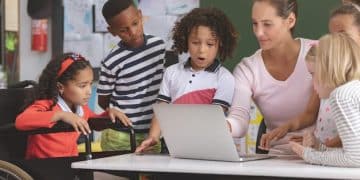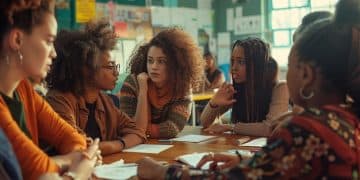New Strategies to Bridge the Achievement Gap in Education

New strategies for closing the achievement gap between different student groups encompass personalized learning, culturally responsive teaching, early childhood interventions, socio-emotional support, and community involvement to ensure equitable educational outcomes.
Addressing disparities in academic performance requires a multifaceted approach. Let’s explore what are the new strategies for closing the achievement gap between different student groups, focusing on practical and impactful solutions.
Understanding the Achievement Gap
The achievement gap refers to the disparity in academic performance between different groups of students, often based on race, ethnicity, socioeconomic status, and other factors. Addressing this gap is crucial for creating a more equitable and inclusive educational system.
Defining the Achievement Gap
The achievement gap is not a new phenomenon, but it remains a persistent challenge in education. It reflects systemic inequalities and disparities in access to quality education and resources.
Factors Contributing to the Gap
Several factors contribute to the achievement gap, including poverty, lack of access to quality early childhood education, inadequate resources in schools, and cultural biases in the curriculum. Understanding these factors is essential for developing effective interventions.
- Socioeconomic disparities: Students from low-income families often face significant barriers to academic success.
- Racial and ethnic biases: Systemic biases can impact students’ opportunities and academic outcomes.
- Access to resources: Unequal distribution of resources in schools can exacerbate the achievement gap.
- Early childhood education: Lack of access to quality early childhood programs can set students back from the start.
Addressing the achievement gap requires a comprehensive approach that tackles these underlying factors.
Personalized Learning: Tailoring Education to Individual Needs
Personalized learning is an educational approach that aims to tailor instruction to the individual needs, strengths, and interests of each student. This approach can be particularly effective in closing the achievement gap.

Benefits of Personalized Learning
Personalized learning can lead to increased student engagement, improved academic outcomes, and greater self-directed learning skills. By addressing individual needs, it helps students to succeed at their own pace.
Implementing Personalized Learning Strategies
Implementing personalized learning requires a shift in teaching practices and the use of technology to support individualized instruction. Strategies include:
- Differentiated instruction: Adapting teaching methods to meet diverse learning needs.
- Adaptive technology: Using software and online tools to personalize learning experiences.
- Student-centered classrooms: Empowering students to take ownership of their learning.
Personalized learning can be a powerful tool for closing the achievement gap by ensuring that all students receive the support they need to succeed.
In conclusion, personalized learning involves customizing educational content and methods to suit each student’s unique learning style, pace, and interests, thereby enhancing engagement and academic outcomes by addressing individual needs effectively.
Culturally Responsive Teaching: Recognizing and Valuing Diversity
Culturally responsive teaching is an approach that recognizes and values the cultural backgrounds of students, incorporating their experiences and perspectives into the curriculum. This approach fosters a more inclusive and supportive learning environment.
Why Culturally Responsive Teaching Matters
Culturally responsive teaching acknowledges that students come from diverse backgrounds and that their cultural identities can play a significant role in their learning. By valuing and respecting these differences, educators can create a classroom where all students feel seen and heard.
Strategies for Culturally Responsive Teaching
Implementing culturally responsive teaching involves:
- Incorporating diverse perspectives: Including materials and examples that represent different cultures.
- Building relationships: Getting to know students’ backgrounds and experiences.
- Creating inclusive classroom environments: Establishing a classroom culture that values diversity.
Culturally responsive teaching promotes equity by ensuring that all students feel valued and respected in the classroom.
Essentially, culturally responsive teaching involves integrating students’ cultural backgrounds and experiences into the learning process, creating a more inclusive and relevant educational environment.

Early Childhood Interventions: Setting the Foundation for Success
Early childhood interventions are programs and services designed to support young children’s development and learning, particularly for those from disadvantaged backgrounds. These interventions can have a lasting impact on academic outcomes.
The Importance of Early Childhood Education
Research shows that high-quality early childhood education can improve cognitive and social-emotional development, setting children on a path to academic success. Early interventions are particularly crucial for children from low-income families.
Types of Early Childhood Interventions
Several types of early childhood interventions have been shown to be effective, including:
- Head Start: A comprehensive program that provides education, health, and nutrition services to low-income children and families.
- Early Head Start: A program that serves infants, toddlers, and pregnant women from low-income families.
- Home visiting programs: Programs that provide support and education to families in their homes.
By investing in early childhood interventions, we can help to close the achievement gap and ensure that all children have the opportunity to succeed.
Ultimately, early childhood interventions aim to provide young children with the necessary support and resources to foster their cognitive and social-emotional development, leading to better academic outcomes.
Socio-Emotional Support: Addressing Non-Academic Factors
Socio-emotional support focuses on developing students’ social and emotional skills, such as self-awareness, self-regulation, and empathy. These skills are essential for academic success and overall well-being.
The Role of Socio-Emotional Learning (SEL)
SEL programs help students to develop the skills they need to manage their emotions, build relationships, and make responsible decisions. These skills can have a positive impact on academic performance, attendance, and behavior.
Implementing Socio-Emotional Support
Implementing socio-emotional support in schools involves:
- Integrating SEL into the curriculum: Teaching social and emotional skills alongside academic content.
- Providing counseling services: Offering support to students who are struggling with mental health or emotional issues.
- Creating a positive school climate: Fostering a sense of belonging and support among students and staff.
Socio-emotional support addresses non-academic barriers to learning, helping students to thrive both academically and personally.
In short, socio-emotional support involves cultivating students’ social and emotional skills, such as self-regulation, empathy, and relationship-building, which are crucial for academic success and overall well-being.
Community Involvement: Engaging Families and Local Resources
Community involvement emphasizes the importance of engaging families, local organizations, and other community resources to support student learning and development. This approach strengthens the connection between school and home.
Why Community Engagement Matters
Community engagement recognizes that schools cannot address the achievement gap alone. By working together with families and community partners, schools can create a more supportive and enriching environment for students.
Strategies for Community Involvement
Strategies for community involvement include:
Community involvement leverages the resources and expertise of the broader community to support student success.
Put simply, community involvement integrates families, local organizations, and community resources into the educational process, creating a robust support system that enhances student learning and development.
Data-Driven Decision Making: Using Data to Inform Instruction
Data-driven decision making involves using data to inform instructional practices and school policies. By analyzing student data, educators can identify areas of strength and weakness and tailor their instruction accordingly.
The Power of Data Analysis
Data analysis can provide valuable insights into student learning and achievement. By tracking student progress, educators can identify students who are falling behind and provide targeted interventions.
Implementing Data-Driven Practices
Implementing data-driven practices requires:
- Collecting and analyzing student data: Using assessments and other measures to track student progress.
- Using data to inform instruction: Adjusting teaching methods and curriculum based on student data.
- Monitoring the effectiveness of interventions: Tracking the impact of interventions on student outcomes.
Data-driven decision making ensures that educational practices are based on evidence and are effective in improving student outcomes.
To summarize, data-driven decision-making leverages the analysis of student data to guide instructional strategies and school policies, ensuring that interventions are targeted and effective in improving student outcomes.
| Key Strategy | Brief Description |
|---|---|
| 🎯 Personalized Learning | Tailoring education to meet individual student needs, strengths, and interests. |
| 🌍 Culturally Responsive Teaching | Incorporating students’ cultural backgrounds and experiences into the curriculum. |
| 👶 Early Childhood Interventions | Providing support and resources for young children’s development and learning. |
| ❤️ Socio-Emotional Support | Developing students’ social and emotional skills for academic success. |
Frequently Asked Questions (FAQ)
▼
The achievement gap refers to the observed disparity in academic performance between different groups of students, often based on race, ethnicity, or socioeconomic status.
▼
Personalized learning caters to individual student needs, strengths, and interests, fostering engagement and improving academic outcomes by tailoring instruction.
▼
Culturally responsive teaching creates a more inclusive environment by recognizing and valuing students’ diverse cultural backgrounds, making learning more relevant and accessible.
▼
Early childhood interventions provide support and resources to young children, particularly those from disadvantaged backgrounds, to improve their cognitive and social-emotional development.
▼
Community involvement leverages the resources and expertise of families and local organizations to support students’ learning and development, creating a strong support network.
Conclusion
Closing the achievement gap requires a comprehensive and multifaceted approach that addresses individual student needs, values diversity, and engages families and communities. By implementing strategies such as personalized learning, culturally responsive teaching, early childhood interventions, socio-emotional support, and data-driven decision making, we can create more equitable and inclusive educational opportunities for all students.





